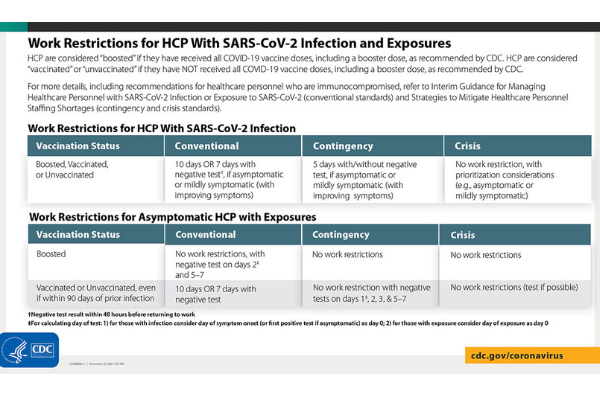
Citing a potential surge in COVID-19 cases due to the omicron variant, the Centers for Disease Control and Prevention (CDC) recently released emergency isolation and quarantine guidelines for health care professionals to assist with staffing shortages.
The updated guidance, which differs from that for the general public, advises:
- Health care professionals with COVID-19 who are asymptomatic can return to work after seven days with a negative test, and that isolation period can be cut further if there are staffing shortages; and
- Health care professionals who have received all recommended COVID-19 vaccine doses, including a booster, do not need to quarantine at home following high-risk exposures.
Isolation relates to behavior after a confirmed infection, whereas quarantine follows exposure to the virus but without a confirmed infection, according to the agency.
“Our goal is to keep health care personnel and patients safe, and to address and prevent undue burden on our health care facilities,” CDC Director Rochelle Walensky, MD, said in a statement. “Our priority remains prevention – and I strongly encourage all health care personnel to get vaccinated and boosted.”
CDC also updated its guidance for contingency and crisis management in settings with significant health care worker shortages.
In contingency settings, health care professionals with asymptomatic or mildly symptomatic COVID-19 infections can return to work after five days of isolation, regardless of whether they have a negative test result, as long as their symptoms are improving.
In crisis settings, health care personnel with COVID-19 infections do not have to isolate, although employers may institute tiered work restrictions based on level of severity. For example, asymptomatic and mildly symptomatic health care workers would not have to isolate in a crisis scenario, whereas those with symptomatic cases would isolate for an abbreviated period.
This guide from CDC explains the work restrictions for health care workers based on whether they have been infected or exposed, and according to staffing needs ranging from conventional to crisis.
These guidelines only apply to health care workers, and CDC may revise them in the future as additional information about the omicron variant becomes available.
Emma Freer
Associate Editor
(512) 370-1383